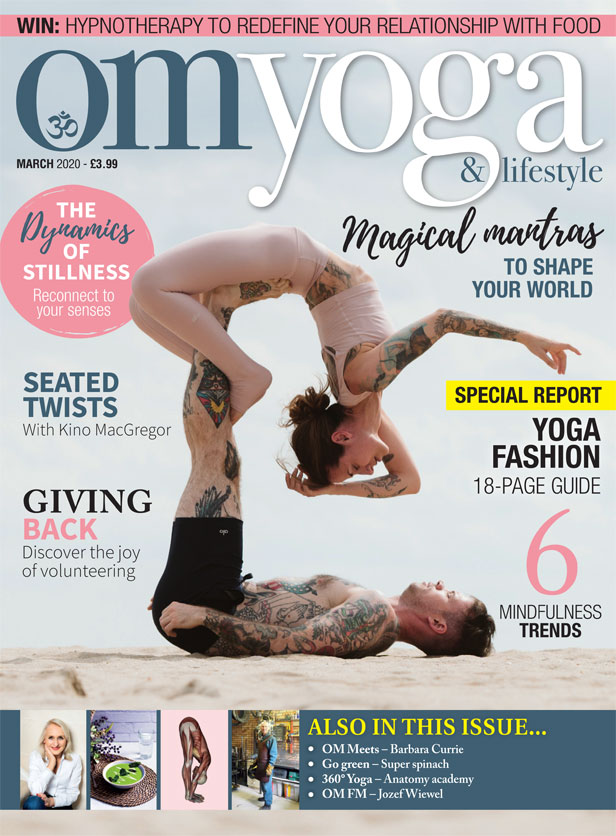
Magical Mantras
Kerry Curson explores the power of mantras and their ability to shape our inner and outer worlds
Have you ever contemplated the beauty of sound? The way in which a certain song can send us through the portals of time, taking us back to the joys of good times gone by; a birthday party, wedding or holiday. We’ve all heard a song so contagious that its rhythm has a part of us insisting we move. Even the anti-dancers might be caught bopping their head in subtle approval or tapping a foot in quiet joy. The truth is that sound has something innately powerful about it, primal, transformative and intuitively healing. Ultimately, sound is a culmination of vibrations strung together in an endless, limitless, infinite variety of patterns.
There is a sound for each of us to fall in love with.
The ancient yogis knew the healing powers of sound before science could ever have verified it. Through these discoveries and their recordings in the canonical texts of yoga from the Vedas to the Upanishads, among others, humankind has been gifted with the knowledge and wisdom of mantra.
According to Georg Feuerstein in his book The Yoga Tradition the route of the word Man can be translated as ‘to think’ or ‘be intent’, also found in the terms Manman ‘to ponder intently’ or Manas ‘mind’. The suffix tra in Mantra suggests instrumentality. Others have associated it with trana suggesting saving or salvation of the mind through concentration of the mind.
Essentially, mantras are phrases that have the power to pierce through the fluctuations of the mind, ‘citta vritti nirodah’, creating a deep sense of peace. The human mind is so complex: on a normal day, an average person might think up to 80,000 thoughts. While many of those thoughts pass across our consciousness like birds in a sky, a fleeting presence, some do stick. The thoughts that stick then feed into an accompanying emotion; this emotion then feeds back to the mind often giving rise to similar thoughts which creates a cycle of thoughts feeding emotions and vice versa. This is where thoughts that are negative in nature can quickly lead to a downward spiral in our mood. Even if the emotion is not strong enough to take hold of us for longer than the initial thought process itself, all of us will still find that the thoughts that we engage with do lead us into a realm of associated emotions that fluctuate all day, every day.
From thought to sticky thought in any one day our moods and emotions might flit from total elation to complete despair. For most of us this is a state of stasis, a normality that we barely even notice because its realm is so familiar. For another growing portion of us our thought patterns can find their way into a perpetual cycle of negativity, perhaps set off by a single event or many small ones. This might then be diagnosed as depression — or not. For many people, I’m sure a state of stress or anxiety is simply accepted without seeking medical diagnosis at all.
Whatever the colour palette of your inner landscape the healing power of sound has been given wings in order to reach us all in the form of mantra. A mantra works as a tool to interrupt and redirect the thoughts, giving way to greater inner quiet. With fewer thoughts surfing across the tide of our consciousness, we can begin to relax, our emotions can transform from choppy seas to calm oceans allowing us to more readily flow with the tides of life. There is certainly no cure for hardship, and it is important to remember that we will all hit obstacles and low points at different times in our life, but practices such as yoga, meditation and mantra can influence the way we handle the tough times as well as the good. They give resilience and equanimity to the mind.
Linguistically, Sanskrit is said to be the perfect language; each letter, vowel or consonant has its own sacred vibration, and so mantras from yogic and Buddhist traditions are still used in their original Sanskrit format. A mantra might invoke a certain deity or state of being. I try to encourage students not to get too bogged down with the whys and wherefores, especially if religious or spiritual connotations leave you feeling uncomfortable. Thinking of translations more like metaphor may help you feel more open to trying a mantra practice if it seems a little alien at first.
Traditionally, a mantra would have been chosen for an aspirant by a spiritual guide, or an experienced teacher. Today, there are some universal mantras that are prescribed for wider use. As you scan through the following try to pick whichever resonates with you on an intuitive level without too much thought or analysis. Once you choose your mantra, you can use it in several ways; as part of a meditation practice whereby you sit silently repeating your mantra for a set amount of time each day or twice a day. During this practice the mantra acts as your mind’s anchor. Each time the mind wanders draw your attention back to the mantra until you become completely absorbed by it. If you are completely new to meditation, five minutes a day might be a good time to start with, keeping the importance on consistency rather than the length of time you sit for. It’s important to remember that you are not looking to achieve any particular outcome as part of any meditation practice. Some days your mind might feel in complete turmoil and you feel fidgety and perhaps finish five minutes feeling like you didn’t ‘meditate’ at all. It is simply a matter of returning again and again, whatever arises, without judgement or repression of thoughts and emotions. In time, the mind becomes more disciplined and will steady itself more easily. The benefits of your practice are a culmination of all the dedication you give to it across the long term, not based around a single experience on any particular day.
For those experiencing lots of stress and anxiety it can be too much to go inward so deeply with silent mantra meditation at first. In this case, chanting your mantra may be of more service to you to begin with. Once you have picked your mantra you may find it useful to search for it on whichever app you use to listen to music or meditations (Insight Timer is a great, free app): here you will find an array of variations on the rhythm and melody with which to chant. You may find this useful to really engross yourself in practice to start with. You can then chant as part of a set daily practice or while completing mundane chores or mechanical tasks like cleaning or showering and getting dressed. It is, however, recommended not to practice your mantra while driving or doing any other task that requires your full concentration. Your mantra is your single point of focus when in practice. It should be intended as this and not as a distraction from things that demand your focus like driving, reading, writing or listening to a person in conversation.
You can also practice throughout the day. Mantra is most powerful when repeated silently. It doesn’t need to be part of a stringent meditation practice although the culmination of chanting, meditation and repeated repetition will bring greater benefits in partnership, each enhancing the other. Author of The Mantram Handbook, Eknath Easwaran suggests silently repeating your chosen mantra in the spaces of waiting during the day; whether it’s when you’re stuck in traffic, standing in line, or simply to move your attention away from thoughts that arise which do not serve you. This way your mind will become sharp like a laser beam and able to turn its attention to any task without the distraction of limiting beliefs or unproductive thoughts getting in your way.
Some beautiful and commonly used mantras are:
Om Namah Shivaya
A salutation to Lord Shiva who represents the destructive phase of existence. Sometimes destruction must take place to make space for new beginnings. Shiva sweeps the pathway free for this to happen.
So Hum
I am that. Repeated constantly this simply translates again and again as I am that I am that I am. Essentially representing the limitless Self, the deepest part of your being beyond mind and personality. This is sometimes referred to as the soul, inner divinity or the essential Self among many other translations.
Om Mani Padme Hum
This is a Buddhist mantra, not directly translatable but understood as the jewel of the heart, another symbol of your purest essence.
Om Gam Ganapataye Namaha A salutation to Ganesh
A salutation to Ganesh the deity that is most simply defined as the remover of obstacles.
Om
Finally, for the simplest and most universal mantra to speak of and one probably the most associated with yoga, Om is that which is beyond words, the vibration of the universe offering a pathway to bring us back into alignment with the oneness of Nature, Divinity, Grace or God; all potentially being one and the same.
These are just a handful of mantras commonly used. There are many, many more out there. In fact, there are unique mantras used by most religious traditions and more from the yoga tradition, one for every deity in fact. Once you have chosen a mantra to work with, be disciplined with how you practice it and trust in the process, the devotion to it can be as powerful a practice as using the mantra itself. You never know it might just make the space you need to manifest more than you ever thought possible
Kerry Curson is a yoga instructor and teaches across the west coast of Wales and other selected locations. She shares her experiences of yoga and motherhood on Instagram @kerrycursonyoga




